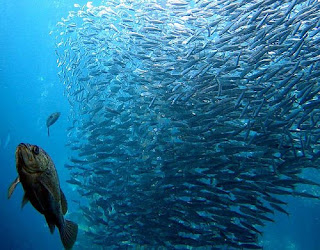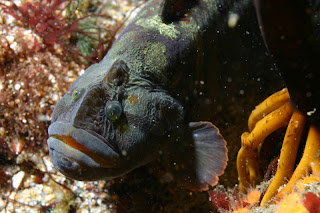A plucky group of divers showed up at Coral Street for the morning fish survey: entymology professor Bob, Venture Crewmember (used to be called Explorer Scout) Cameron, mechanical engineers Will, Mina & Peter (coincidence, none had met before), and elementary school teacher (and long time fish surveyor) Alan. Peter did the survey as a freediver (he later let on that he was on the US national free diving team in 2004), which was of great interest, to see what anon-bubble-blower could sneak up on (answer: Opaleye). Peter, free diving, went out farther and dove deeper than any of the SCUBA divers. We were impressed (cool carbon fiber fins, too).
Ocean conditions were very pleasant: flat, with nice 20' viz. And the fish were there, showing off. Hoards of JUVENILE ROCKFISH hovering over the reef !!! (very encouraging, after several years of NO juvenile rockfish, essentially a drought since 2001). These are"black-spot-on-the-dorsal-fin" juveniles - my guess is black rockfish, with a smattering of yellowtail, but I'm eager to hear whatTom Laidig says. Peter says they're even more abundant past the outer edge of the kelp. And scores of beautiful rainbow seaperch graced the nearshore end of the sand channel, one of the prettier fish in our area. Our group list was quite respectable for first-time fish counters:
- Kelp Greenling
- Painted Greenling
- Blue Rockfish
- Black Rockfish
- Kelp Rockfish
- Opaleye
- Monkeyface Prickleback Eel
- Cabezon
- Black-Eye Goby
- Black Seaperch
- Kelp Seaperch
- Pile Seaperch
- Rainbow Seaperch
- Striped Seaperch
- Senorita
Went over to the aquarium in the afternoon to meet Gil Falcone forthe fish ID seminar, which the aquarium graciously lets us hold in their upstairs classroom. Gil and I have done this for several years now - this time we decided to try to do it in a Click & Clack Tappit Brothers style of back & forth that made it more fun for us to give. The audience of morning divers were augmented by some curious aquarium volunteers, a couple more ba_divers, and by more Venture Crew young adults from Davis who hadn't yet let learned to SCUBA dive (the Venture Crew in Davis is pretty cool, it has diving as one of their main activities - thanks to Bob's tutelage and Will's help). Folks even grokked the "Blurry Moving Video Fish Quiz" at the end (strictly self-test, I've learned not to ask folks how well theydid on it, I always forget how hard/tricky this fish ID stuff is when you're first starting out). Gil then led us through the kelp tank area of the aquarium - if you haven't seen the new smaller kelp tanks upstairs near the big kelp tank, it's definitely worth checking out. Several Southern California fish species in there too, handy to view for brushing upon your southern species (Sargo, Salema, Halfmoon, etc) before your next trip to the Channel Islands.
Dropped by Tabouli's restaurant on Lighthouse Avenue before heading home. Had to "warn" Christophe that Rachid was coming to town (they're friends, Rachid camps at Veterans' campground, dives everyday, and uses Tabouli's as his living room each evening). If you haven't met Rachid yet, know that a few years back he was one the zanier characters in our local diving scene - before moving toLouisiana to care for his ailing mother. GAFC events coming up: Steve Lonhart's marine invertebrate ID presentation on Monday and Mike Davis' basic north central californiafish ID class on Tuesday, both at 7pm, offered by the Dive Club of Silicon Valley (DCOSV) at Diver Dan's in Santa Clara; and then DCOSV's fish count & picnic at Lovers Point in Pacific Grove on Saturday, July 12.
Monday, June 30, 2008
Great Annual Fish Count -- A Different Perspective
The following dive report was posted by John Wolfe on the BA_diving Yahoo Group chronicling the Great Annual Fish Count dive that occurred last Saturday:
Sunday, June 29, 2008
Great Annual Fish Count (Or 'I Love Rockfish')
 I joined John Wolfe and his group for their Annual Fish Count dive at Coral Street Beach. I considered this dive day to be a treat. I had heard that John Wolfe was one of the main players involved with zoning the California Marine Protected Areas (he was formerly a stakeholder on the Central Coast Regional Stake Holder Group), so I was looking forward to diving with him. Doubly a treat was the fish ID seminar that was being held at the Monterey Bay Aquarium later that afternoon, followed by an impromptu fish ID dive through the aquarium.
I joined John Wolfe and his group for their Annual Fish Count dive at Coral Street Beach. I considered this dive day to be a treat. I had heard that John Wolfe was one of the main players involved with zoning the California Marine Protected Areas (he was formerly a stakeholder on the Central Coast Regional Stake Holder Group), so I was looking forward to diving with him. Doubly a treat was the fish ID seminar that was being held at the Monterey Bay Aquarium later that afternoon, followed by an impromptu fish ID dive through the aquarium.Meeting John Wolfe was great. He is an enthusiastic, trim, 50-something man who looks like he could be in his early 40s. He has bright blue eyes that open wide when he talks about something that he is excited about. I have not met anyone more animated about fish.
The Annual Fish Count is an event sponsored by REEF (Reef Environmental Education Foundation). It enlists recreational divers to identify and count fish (no more than 1.5 hours of training was necessary to start counting). The data is used by scientists and divers to support the setting aside of marine protected areas. California is the first American state to vigorously set aside marine protected areas as fish nurseries for revitalizing the fish population (here is an excellent broadcast from NPR on the unique California program).
At first, I thought the REEF fish count was a gimmick to sell Paul Humann's fish ID books. The fish identification methodology used by REEF follows Paul Humann's loosey-goosey categorization of fish in terms of body shape instead of genus or family. But as I learned that the data was being used to justify the setting aside of Marine Protected Areas, and when I experienced how FUN it was to count fish in such a simple, laymen's manner, my mind changed.
After the dives themselves, we were treated to a seminar held at the Monterey Bay Aquarium and taught by Gil Falcone, the chief diving safety officer at the museum. We were then allowed to wander the Monterey Bay Aquarium for free, with an impromptu guided tour by Gil Falcone and John Wolfe.
As the group mingled in front of the kelp forest exhibit (see below), I exclaimed to noone in particular: "I love rockfish". Among less enthusiastic people, I would have been a bit embarrassed to exclaim such a statement. But given that John goes around quoting the life spans of rockfish species to other divers (counting in the hundreds of years for a couple of species), I didn't feel so bad.
My favorite rockfish species to date is the kelp rockfish (see first pic above), otherwise known as the "dumb bass" by divers and scientists. They seem pretty stupid, which is why I like them so much. They are unperturbed by divers (you can get within inches of them), and they like to hang out vertically in the water column (also see above pic) for some inexplicable reason. On Dive #1 of the day, when I nudged a cluster of eggs with my finger, a kelp rockfish came within a couple of feet of me to investigate what I was looking at. I love it when fish do that. They are not just these automatons in the water, but exhibit what I think of as personality.
Meeting Gil Falcone (the chief diving safety officer) was pretty cool, too. I asked what the Aquarium dive volunteer requirements were, and when we found out that I wasn't qualified (I live too far away), he suggested that I volunteer at the newly opening Steinhard Aquarium in SF. I also found out some insider aquarium information from Gil. For instance, did you know that:
- Resident Great White Shark #1 was released because it had nose injuries and because it was too difficult to repeatedly swab the area for infection (shark didn't like this too much).
- Resident Great White Shark #2 was released because it was hunting other sharks.
- Resident Great White Shark #3 was released because it was jumping full body lengths out of the water!
Anyways, my dives in detail from the day follow. Allen, who has been counting fish for REEF for the past 8 years, was my dive buddy, and helped me to identify the various fish species:
 A Face Only A Mother Could Love
A Face Only A Mother Could Love
Monkeyface Prickleback Eel (photo courtesy of the Monterey Bay Aquarium)
Dive #1: Coral Street (Cumulative Dive #159)Max Depth: 30? feet
Time: 1:00 hour
Buddy: Allen
Temperature: Oceanic Computer 47 deg. F (53 deg. F)
Visibility: 20+ feet
Weight worn: 24 lbs (20 on weight belt, 4 in BCD)
Observations:
Coral Street Beach was an awesome shore dive where I saw perhaps my most unique fish sighting of the year, a Monkeyface Prickleback Eel (see above). Unfortunately, a predator (a cormorant?) had gouged its eye out, so the fish did not seem at all healthy. This explains why it was all the way out in the open during daytime. Other sightings:
- black and blue rockfish
- black seaperch
- pile perch
- painted greenlings
Max Depth: 39 feet
Time: 1:07 minutes
Buddies: Allen
Temperature: Oceanic Computer 47 deg. F (53 deg. F)
Visibility: 20-40 feet
Weight worn: 24 lbs (14 on weight belt with two 5ers in foremost pockets, 10 lbs in BCD).
Observations:
Awesome dive, and longest dive in Monterey to date (courtesy of my drysuit). We went way past the shallow reef to the deeper reef. Vis varied from 40+ feet at the sandbed between the two reefs, to 20 feet. We saw clouds of juvenile rock fish in the hundreds! Hopefully this bodes well for the rockfish population in years to come. Also, we saw a fat harbor seal that rubber necked us as it continued on its way.
Subscribe to:
Posts (Atom)
20 Goals for 2019
I know the year is already half over, but here are my goals for 2019 (this was not finished earlier as my goals kept changing). Soci...

-
Bannerfish Ever since reading “Travels” , by Michael Crichton of Jurassic Park fame, I’d been fascinated with Rangiroa Atoll. In hi...
-
Stuff You Should Bring Mosquito Spray. Bring or buy one can of mosquito spray for each person, for every week spent in French Polynesi...
-
We recently returned from our honeymoon in Fiji. It was our first time travelling to the South Pacific, and I'm excited to share my imp...


